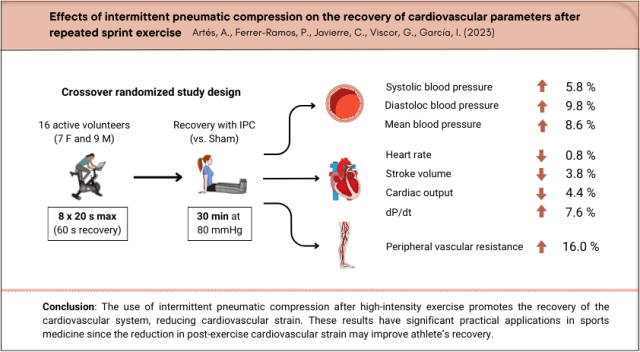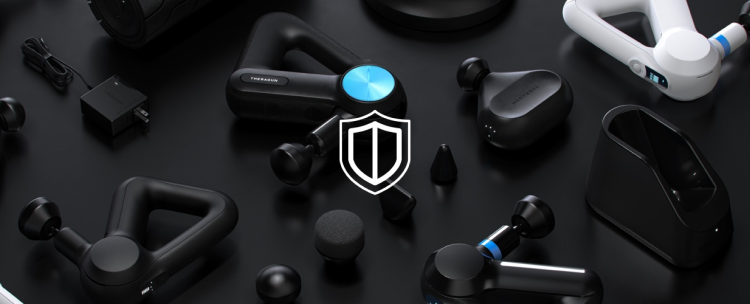Authors: Therabody Scientists: Tim Roberts, MSc; Kyle Silvey, PhD; Michelle Darian, MS, MPH, RD, LDN
Recovery time is often the limiting factor in any fitness routine. And the harder the work, the further from your resting baseline you push your limits, and the greater the distance your body has to travel back to its start. But recovery shouldn’t necessarily mean just resting. Technology can actually help expedite the recovery process — getting you into your next workout better and faster than simply taking it easy. Especially pneumatic compression garments.
Scientists of a 2023 study published in the European Journal of Applied Physiology were the first to investigate the impact of pneumatic compression boots on measures of heart health and overall recovery after an all-out intensity exercise session. [1] And sure enough, this treatment promoted a quicker return to participants’ baseline heart health metrics than rest alone.
Let’s take a closer look at these findings.
How Was The Study Set Up?
Researchers of this study were particularly interested in how an intermittent compression device compared to a typical resting recovery on specific measures of heart health after high-intensity exercise. And they used Therabody’s RecoveryAir PRO device for the treatment.
Now, intermittent pneumatic compression is a specific type of compressive therapy in which compressed air is delivered to a designated area of the body — usually the peripheries like the arms and legs — in a sequential manner. This squeezing and release of pressure helps the blood and lymph circulate, both of which play pivotal roles in promoting recovery. [2]
To discern the difference between the two recovery methods, a total of 16 participants (seven females and nine males) who regularly participate in high-intensity interval exercise completed two of the same cycling sprints with a different recovery method each time.
Before the sprint test began, everyone had their resting heart health measurements taken, including blood pressure, heart function, and peripheral vascular resistance. They then underwent a cycling-based exhaustive sprint interval immediately followed by a 30-minute recovery with either RecoveryAir PRO pneumatic compression boots or rest. Those same heart health measures were captured at each phase.

Results Showed Intermittent Pneumatic Compression Helped Speed Up Recovery
The use of intermittent pneumatic compression using Therabody’s RecoveryAir PRO device during the recovery phase led to a faster cardiovascular recovery and reduced cardiovascular strain for blood pressure levels, cardiac output, and peripheral vascular resistance.
- A faster return to pre-exercise blood pressure: When you exercise, your muscles need more oxygen and more energy, so your heart pumps harder to deliver it. This typically increases your heart rate and blood pressure levels. [3] After exercise, you want your blood pressure to return to normal to help properly clear waste products (that accumulated from exercise) from the blood. Prolonged elevated blood pressure after exercise can put extra strain on your heart. So, this study showed pneumatic compression was more efficient than rest at helping blood pressure levels return to pre-exercise levels.
- Improved cardiac output: Cardiac output refers to the amount of blood your heart pumps each time it beats. During exercise, cardiac output increases to (again) make sure the muscles are getting the oxygen and nutrients they need to keep going. Prolonged high cardiac output after exercise indicates that your heart is working harder than necessary. [4] Pneumatic compression also helped the rebound of cardiac output after exercising, alleviating this aspect of cardiac strain more so than rest alone.
- Improved peripheral vascular resistance: This is the resistance that blood encounters as it flows through the small blood vessels in your body (think your hands, feet, arms, and legs). After exercise, these vessels should ideally relax and widen to allow for more blood flow (bringing oxygen and nutrients and sweeping away waste). [5] A faster return to pre-exercise values in vascular resistance is a good sign of efficient recovery. And that’s exactly what the pneumatic compression boots helped with.
It’s also important to note that the use of pneumatic compression in this study did result in a slower recovery in cardiac pressure. This could be a positive adaptation because while we want to help the heart transition swiftly back to its resting state, that change shouldn’t necessarily be abrupt. This could lead to drops in blood pressure that cause dizziness or even fainting post-exercise. [6] So, a gradual transition can be a good thing.
However, if the cardiac pressure change is too slow for an extended period, it can prolong cardiac stress and delay recovery.
What Do These Results Mean For You?
Using Therabody’s RecoveryAir boots immediately after a workout can not only help out your legs, but also kickstart your cardiovascular recovery. This is especially important for those who are competing, training, or working out more than once a day, or implementing a change in training volume or intensity.
But anyone with a fitness routine that regularly includes high-intensity training can benefit from pneumatic compression to aid their recovery.
This Study Adds to Our Understanding of Pneumatic Compression’s Recovery Benefits
Pneumatic compression is not a new therapy — it’s been around since the 1950s, originally used to help control swelling and prevent blood clots from forming in the legs of hospitalized patients. [7]
So, there are actually decades worth of data already showing the benefits of pneumatic compression on circulation of blood and lymph. More specifically, previous studies show that intermittent pneumatic compression can help other measures of recovery such as:
And taking this new study into consideration, it’s even more apparent that intermittent pneumatic compression offers a comprehensive approach for exercise recovery.
Key Takeaways
- This was the first study to investigate the impact of intermittent pneumatic compression on measures of cardiovascular recovery after an all-out intensity exercise session.
- A total of 16 participants completed two high-intensity cycling sprint tests with different recovery methods: Therabody’s RecoveryAir pneumatic compression boots or rest.
- Results showed that the use of pneumatic compression helped improve measures of heart health strain more quickly than rest alone.
- Overall, pneumatic compression garments may help promote and expedite recovery after high-intensity workouts, but more research is needed to understand its full effects.
References:
- https://pubmed.ncbi.nlm.nih.gov/37792163/
- https://link.springer.com/chapter/10.1007/978-0-387-45951-6_70
- https://pubmed.ncbi.nlm.nih.gov/27468357/
- https://www.ncbi.nlm.nih.gov/pmc/articles/PMC6172294/
- https://www.ncbi.nlm.nih.gov/pmc/articles/PMC5007320/
- https://www.ncbi.nlm.nih.gov/pmc/articles/PMC2936915/
- https://journals.sagepub.com/doi/10.1177/1076029616683044
- https://pubmed.ncbi.nlm.nih.gov/10757194/
- https://www.ncbi.nlm.nih.gov/pmc/articles/PMC150384/
- https://pubmed.ncbi.nlm.nih.gov/27533094/
- https://www.ncbi.nlm.nih.gov/pmc/articles/PMC8067745/







